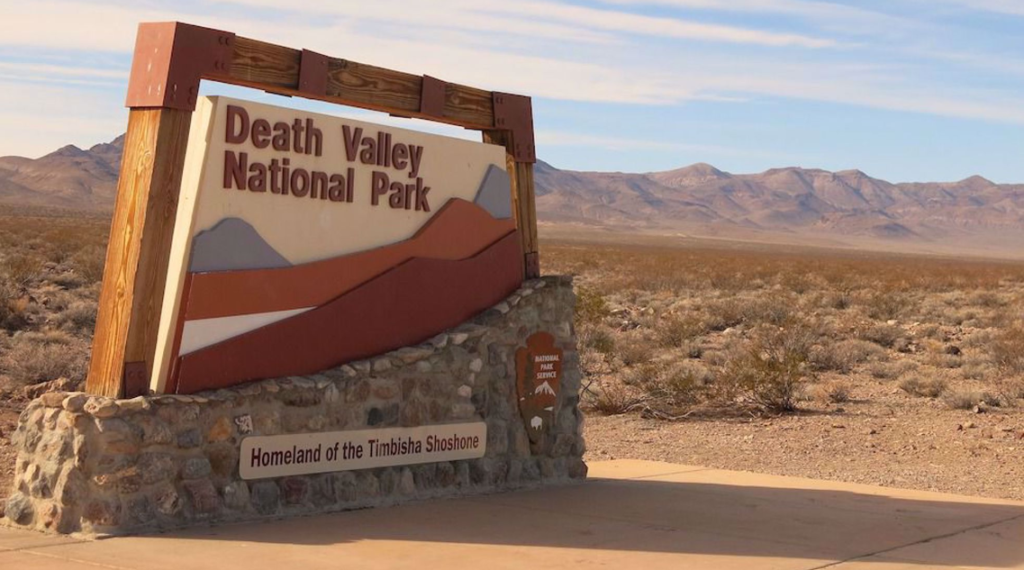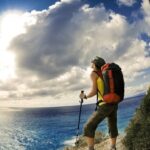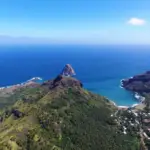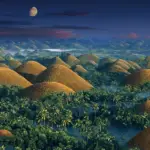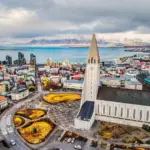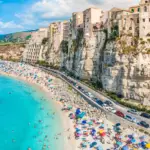
THE Death Valley National Park is a breathtaking destination for nature lovers and adventurers looking for challenges and experiences unique. Located in Southern California, in the United States, this park is famous for its natural beauty, climate extreme and landscapes stunning.
With sand dunes, peculiar rock formations and an exceptional variety of flora and fauna, the Death Valley National Park is a destination for those seeking an unforgettable adventure.
Main Conclusions:
- THE Death Valley National Park is an exciting destination for nature lovers and adventurers looking for challenges and experiences unique;
- Located in Southern California, United States, the park is famous for its natural beauty, climate extreme and landscapes stunning;
- With sand dunes, peculiar rock formations and an exceptional variety of flora and fauna, Death Valley National Park offers visitors an unforgettable adventure.
Location and History of Death Valley National Park
Death Valley National Park is located in the state of California, in the United States, covering an area of almost 14,000 km². Its location The geographic area is unique and extends across Inyo and San Bernardino counties in California and Esmeralda in Nevada.
THE history The park's history dates back to prehistoric times, when the region was inhabited by various indigenous tribes. Later, the valley was the site of the famous California Gold Rush, which led to the construction of roads and railroads. In 1933, Death Valley National Park was created to preserve its unique landscape and ecosystem.

Stunning Climate and Landscapes
Death Valley National Park is a unique place in terms of climate and landscapes, with views that defy the imagination and extreme weather conditions that test the endurance of body and mind. Located in California, United States, the park covers an area of approximately 13,600 km², meaning there's plenty to see and explore.
The climate in Death Valley National Park is arid and dry, with extremely hot summers and cold winters. Temperatures can range from -1°C to 49°C, depending on the time of year and the location within the park. The lack of humidity adds an extra challenge to visitors, who must stay hydrated and protected from the sun to avoid health problems.
Despite the harsh weather conditions, the landscapes of Death Valley National Park are absolutely breathtaking. Highlights include sand dunes, which can reach heights of over 500 feet, and peculiar rock formations, such as stone towers carved by erosion. There are also majestic mountains, deep canyons, and valleys that seem straight out of a science fiction film.

The main landscapes in Death Valley National Park are:
- Badwater Basin: One of the lowest points on Earth, with a white expanse of salt stretching for miles.
- Zabriskie Point: A lookout point offering spectacular views of the surrounding rock formations and valleys.
- Mesquite Flat Sand Dunes: a set of sand dunes that seem endless.
- Artists Drive: A scenic road that passes colorful rocks and surreal geological formations.
It's important to remember that while Death Valley National Park is incredibly beautiful, it's also incredibly dangerous. Visitors should always follow recommended safety precautions and be prepared for emergencies if necessary.
Read on to find out more about the exceptional options flora and fauna that can be found in Death Valley National Park.

Exceptional Flora and Fauna
Death Valley National Park is a unique and extreme location, home to a wide variety of incredible fauna and flora. The desert conditions provide the perfect environment for species that can adapt to the extreme conditions.
The flora is dominated by heat-resistant shrubs and herbs, small wildflowers, and various cacti. Notable species include the beautiful Hornflower, Voltaire's Wedge, Barrel Cactus, Joshua Tree, and others.
The fauna boasts an incredible diversity of animals. Mammals such as coyotes, cougars, deer, desert foxes, badgers, and marmots can be found. Birds such as the common raven, golden eagle, peregrine falcon, and desert crow can also be found. There's also a variety of reptiles, including rattlesnakes and desert iguanas.
Examples of species found in Death Valley National Park:
| Flora | Fauna |
|---|---|
| Barrel Cactus | Coyote |
| Horn Flower | Puma |
| Voltaire Wedge | Deer |
| Joshua Tree Plant | Desert Foxes |
To preserve the unique flora and fauna of Death Valley National Park, it is important to respect park rules, including not feeding wildlife and staying on designated trails to avoid damaging the natural habitat.
Must-See Activities and Attractions
Death Valley National Park is an incredible destination for those seeking adventure and unique challenges in the wilderness. Check out some of the activities and attractions must-sees of the park:
Hiking and Trails
Exploring the trails of Death Valley National Park is an unforgettable experience. There are options for all skill levels, from short hikes to longer, more challenging treks. Popular options include the Golden Canyon Trail, which leads to impressive rock formations, and Badwater Basin, the lowest trail in North America, which offers a unique salt flat landscape.
Rock Climbing
Death Valley National Park is a rock climber's paradise, with a wide variety of climbing options available. There are many climbing areas with breathtaking cliffs and unique rock formations that pose a real challenge for even the most experienced climbers.
Car Tours
A comfortable and fascinating way to explore the park is by car. One of the most popular routes is Dante's View, which offers panoramic views of Death Valley from an altitude of over 5,500 feet.
Points of Historical Interest
Death Valley National Park is also a place of great historical significance. There are several landmarks within the park, including the Harmony Borax Works, a former mining site, and the ruins of the Ashford Mill settlement.
Natural Landscapes
Death Valley National Park is known for its incredible natural landscapes, including sand dunes, canyons, unique rock formations, and more. Among the park's most impressive sights are the Artist's Palette, a collection of colorful mountains, and the Mesquite Flat Sand Dunes, a vast field of sand dunes.
Stargazing
Death Valley National Park is one of the best places in the world for stargazing, with an incredibly clear night sky free of light pollution. There are several observation points available in the park, and special events are occasionally held to observe astronomical events.
Conclusion
Death Valley National Park is an incredible destination for those seeking challenges and experiences unique in the midst of wild nature. With a wide variety of activities and attractions unmissable, this park is one of the most fascinating destinations in the world.

Travel and Preparation Tips
If you're planning a visit to Death Valley National Park, it's important to be well prepared for the extreme conditions. Here are some helpful tips to ensure a safe and enjoyable trip:
- Check the weather: The weather in Death Valley National Park can be extremely hot during the day and cold at night. Be sure to check the weather forecast in advance and bring appropriate clothing for the conditions.
- Bring plenty of water: Hydration is essential in such an arid environment, so bring enough water for the entire trip.
- Use sunscreen and a hat: The sun can be relentless in Death Valley National Park, so protect your skin and head with sunscreen and a hat.
- Have the right equipment: Make sure you bring the correct equipment for the activities you want to accomplish, such as comfortable walking shoes and polarized sunglasses to reduce sun glare.
- Respect the environment: As a national park, the preservation environmental is extremely important. Make sure you follow all rules and regulations, don't disturb the flora and fauna, and leave the park exactly as you found it.
Security measures
In addition to the tips above, there are some safety precautions you should follow when visiting Death Valley National Park:
- Plan ahead: Be sure to review the park maps and plan your route in advance to avoid getting lost or running out of fuel in the desert.
- Don't underestimate the heat: The dangers of heat can be fatal. Don't go hiking during the hottest hours of the day, and always carry water and sunscreen.
- Have an emergency kit: Keep an emergency kit in your car with extra water, food, a spare tire, and basic medical supplies.
- Observe the signs: Park signs indicate dangerous or restricted areas. Be sure to read and follow all instructions.
- Communicate your plans: Be sure to inform family or friends about your travel plans and update them regularly.
Accommodation and Food
If you are planning a trip to the Death Valley National Park, it is important to be aware of the options accommodation and food available in the area. While the park offers campsites and RV sites, not all visitors want to camp. Fortunately, there are other options available for those who prefer a accommodation more comfortable.
| Hosting | Description |
|---|---|
| The Oasis at Death Valley | Located within the park, it offers rooms, suites, and cottages. It also features restaurants, a golf course, and other amenities. |
| Stovepipe Wells Village Hotel | Located about 40 minutes from the park center, it offers comfortable rooms and suites with views of the sand dunes. |
| Panamint Springs Resort | Located about 40 minutes north of the park, it offers cabins, rooms and campsites. |
In addition to the options of accommodation Inside and near the park, there are also a variety of restaurants to suit all tastes and budgets. Most establishments food within the park is operated by Xanterra Parks & Resorts, the park's official concessionaire.
- The Oasis at Death Valley – offers dining options at two restaurants and a café.
- Stovepipe Wells Village Hotel – has a restaurant and a bar.
- Panamint Springs Resort – has a restaurant and a bar.
- Other options food in the region include pizzerias, Mexican restaurants and fast food places.
Please note that Death Valley National Park is a remote area, and visitors should be prepared to bring their own food and drink, especially if they plan to camp.
Environmental Preservation and Sustainability
Death Valley National Park is a natural treasure that must be preserved and protected for future generations. The efforts of environmental preservation and sustainability are essential to maintaining the integrity and biodiversity of this unique ecosystem.
Conservation measures include protecting sensitive areas, restoring damaged ecosystems, and implementing sustainable practices in all activities within the park. Furthermore, the park team works closely with the local community and businesses to promote responsible and conscious tourism.
Visitors to Death Valley National Park also play an important role in preserving the site. It's essential to follow the park's rules and regulations, respect the fauna and flora, and be mindful of the impact of your actions on the environment.
Finally, it is important to highlight that the environmental preservation and sustainability The preservation of Death Valley National Park is everyone's responsibility. Through individual and collective action, we can ensure this unique destination is enjoyed for generations to come.

Guided Tours and Tourist Packages
One of the best ways to explore Death Valley National Park is through guided tours and tour packages. These services offer an experience even more enriching, with experienced guides who know the place in depth and can provide additional information about the landscapes, history and biodiversity of the park.
To the guided tours can be customized to the visitor's preferences, with options ranging from hikes on specific trails to bike tours and excursions to historical and cultural landmarks. Additionally, many tour companies offer complete packages that include transportation, accommodations, and meals, making the experience more convenient and affordable.
It's important to choose a reliable and verified company to ensure a safe and quality experience. With careful research, you can find options that fit your budget and preferences.
Practical Information and Contact
To visit Death Valley National Park, it's important to be well-informed about transportation options, opening hours, and ticket prices. Check out some tips below. practical information that can help you plan your visit:
| How to Get There | Death Valley National Park is located on the border between California and Nevada in the United States. The most common way to get there is by car from Las Vegas or Los Angeles. It's also possible to fly into Las Vegas International Airport, which is about 125 miles (200 km) from the park. |
|---|---|
| Opening Hours | The park is open every day of the year, but opening hours vary depending on the season. During the summer, for example, trails and attractions are open from 5 a.m. to 10 p.m. In the winter, opening hours are reduced, and some attractions may be closed. |
| Ticket Price | The entrance fee for Death Valley National Park is US$$ 30.00 per private vehicle and US$$ 15.00 per person on foot or by bicycle. Other ticket options include the annual pass, which can be purchased for US$$ 80.00 and grants access to all national parks in the United States. |
| Contact | For more information about Death Valley National Park, you can visit contact with the visitor center by phone (760) 786-3200 or through the official website, which has a chat for customer service. |
With this information in hand, you're ready to explore all the wonders of Death Valley National Park. Don't waste any time and start planning your trip now!
Visitor Testimonials and Experiences
To truly understand the grandeur and beauty of Death Valley National Park, there is nothing better than hearing the experiences of visitors who have already explored its breathtaking landscapes and faced its challenges.
One visitor described Death Valley National Park as a magical place that left an indelible mark on his mind and heart. Another remarked on the incredible sense of vastness and freedom he felt while walking the sand dunes and observing the unique rock formations.
"Death Valley National Park is a unique experience. The feeling of being in the middle of nowhere yet surrounded by so much life is indescribable. I highly recommend it to anyone who has the opportunity to visit." - Ana Paula, São Paulo/SP
Some people shared their experiences on trails and hikes, highlighting the need for preparation suitable for dealing with extreme weather conditions. Others mentioned the importance of respecting and preserving the natural environment and its unique fauna and flora.
Overall, visitors to Death Valley National Park were unanimous in highlighting its stunning beauty and the sense of connection with nature they experienced during their visit. It's undoubtedly a destination worth adding to your must-see travel list.
Conclusion
Death Valley National Park is an incredible destination for nature lovers and adventurers seeking unique challenges and experiences. Throughout this article, we learned a little more about the location and history of the park, its climate and stunning landscapes, the exceptional flora and fauna, the unmissable activities and attractions, travel tips and preparation, accommodation and food options, environmental preservation efforts and sustainability, guided tours and tour packages available and practical information and of contact.
But nothing compares to experiencing the beauty and challenges of Death Valley National Park firsthand. So, if you're a nature lover ready to venture into one of the most extreme places in the world, don't miss this incredible destination.
Your trip will definitely be an experience you'll remember forever. Enjoy and share your experience with us in the comments below!
Until the next adventure in Death Valley National Park!
FAQ
Where is Death Valley National Park located?
Death Valley National Park is located in the state of California, in the United States.
What is the history of Death Valley National Park?
Death Valley National Park was established in 1933 and has a fascinating history dating back millions of years, with evidence of human occupation since prehistoric times.
What is the weather like in Death Valley National Park?
Death Valley National Park has an extreme climate, with very hot summers and mild winters. It is known as one of the hottest and driest places in the world.
What landscapes can I find in Death Valley National Park?
In Death Valley National Park, you'll find stunning scenery, including sand dunes, mountains, canyons, salt flats, and unique rock formations.
What species of flora and fauna are found in Death Valley National Park?
The park is home to an incredible variety of flora and fauna, including cacti, shrubs, migratory birds, mammals such as foxes, coyotes, and even the rare desert tortoise.
What activities and attractions are must-see in Death Valley National Park?
There are a variety of activities to enjoy in the park, including hiking, trails, scenic drives, and visits to historical landmarks like Scotty's Castle.
What travel and preparation tips are important for visiting Death Valley National Park?
It's crucial to be prepared for extreme weather by bringing appropriate clothing, sunscreen, and plenty of water. It's also important to be aware of safety measures and follow park guidelines.
What lodging and dining options are available in Death Valley National Park?
Visitors have options ranging from campsites in the park to nearby hotels and restaurants, offering a variety of choices to suit their preferences.
What are the environmental preservation and sustainability efforts in Death Valley National Park?
The park is dedicated to environmental preservation and sustainability, promoting conservation practices and environmental education to protect the beauty and integrity of the site.
Are there guided tours and tour packages available to explore Death Valley National Park?
Yes, there are guided tour options and tour packages offered to those who wish to explore the park with the guidance of experts, providing an enriching experience.
What practical information should I know before visiting Death Valley National Park?
It is important to be aware of the practical information, such as opening hours, ticket prices, transportation and details of contact for more information about the park.
What do other visitors have to say about their experiences in Death Valley National Park?
Read the testimonies from other visitors to Death Valley National Park and discover how this unique destination can provide unforgettable and inspiring experiences.
Lucas Wanderlust has a tireless spirit of adventure, always seeking new travel experiences. Fascinated by the world and the possibility of exploring unknown destinations, he fell in love with the sense of freedom and self-discovery that traveling alone provides. With a backpack on his back and a heart open to the unknown, Lucas embarks on exciting journeys, where each destination becomes a unique chapter in his life story. He gives himself body and soul to the magic of solo travel, inspiring others to follow in his footsteps and discover themselves through adventure.

